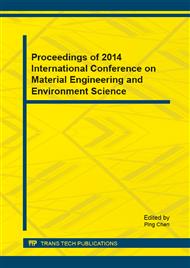[1]
Chang, J. S. (principal author), 1990, The regional acid deposition model and engineering model. Acidic Deposition: State of Science and Technology Report 4, National Acid Precipitation and Assessment Program, Washington, DC.
Google Scholar
[2]
Chang, J. S., R. A. Brost, I. S. A. Isaksen, S. Madronich, P. Middleton, W. R. Stockwell, and C. J. Walcek, 1987, A three-dimensional Eulerian acid deposition model, physical concepts and formulation, J. Geophys. Res., 92, 14681–14700.
DOI: 10.1029/jd092id12p14681
Google Scholar
[3]
Chang, K. -H, J. -Y. Yu, T. -F. Chen, and Y. -P. Lin, 2009, Estimating Taiwan biogenic VOC emission: Leaf energy balance consideration, Atmos. Environ., 43, 5092-5100.
DOI: 10.1016/j.atmosenv.2009.06.038
Google Scholar
[4]
Chang, K. -H., F. -T. Jeng, Y. -L. Tsai, and P. -L. Lin, 2000, Modeling of long-range transport on Taiwan's acid deposition under weather conditions, Atmos. Environ., 34, 3281-3295.
DOI: 10.1016/s1352-2310(00)00072-8
Google Scholar
[5]
Chou, C. C. -K., S. C. Liu, C. -Y. Lin, C. -J. Shiu, and K. -H. Chang, 2006, The trend of surface ozone in Taipei, Taiwan, and its causes: Implications for ozone control strategies, Atmos. Environ., 40, 3898-3908.
DOI: 10.1016/j.atmosenv.2006.02.018
Google Scholar
[6]
CTCI, 2009, The Manual of Air Pollutants Emission Estimation in Taiwan, China Technological Consultant Inc., Taipei, Taiwan (in Chinese).
Google Scholar
[7]
Grell, G. A., J. Dudhia, and D. R. Stauffer, 1993, A description of the fifth-generation Penn State/NCAR Mesoscale Model (MM5), NCAR Technical Note, NCAR/TN-398+STR, Boulder, CO, 117pp.
DOI: 10.1016/s0167-8191(97)00107-5
Google Scholar
[8]
Nagashima, T., T. Ohara, K. Sudo, and H. Akimoto, 2010, The relative importance of various source regions on East Asian surface ozone, Atmos. Chem. Phys., 11305-11322.
DOI: 10.5194/acp-10-11305-2010
Google Scholar
[9]
Ohara, T., H. Akimoto, J. Kurokawa, N. Horii, K. Yamaji, X. Yan, and T. Hayasaka, 2007, An Asian emission inventory of anthropogenic emission sources for the period 1980–2020, Atmos. Chem. Phys., 4419-4444.
DOI: 10.5194/acp-7-4419-2007
Google Scholar
[10]
Richter, A., J. P. Burrows, H. Nüß, C. Granier, and U. Niemeier, 2005, Increase in tropospheric nitrogen dioxide over China observed from space, Nature Publishing Group, 437, 129-132.
DOI: 10.1038/nature04092
Google Scholar
[11]
Tanimoto, H., 2009, Increase in springtime tropospheric ozone at a mountainous site in Japan for the period 1998–2006, Atmos. Environ., 43, 1358-1363.
DOI: 10.1016/j.atmosenv.2008.12.006
Google Scholar
[12]
Wang, K. -Y., 2005, A 9-year climatology of airstreams in East Asia and implications for the transport of pollutants and downstream impacts, J. Geophys. Res., 110, D07306.
DOI: 10.1029/2004jd005326
Google Scholar
[13]
Wang, T., X. L. Wei, A. J. Ding, C. N. Poon, K. S. Lam, Y. S. Li, L. Y. Chan, and M. Anson, 2009, Increasing surface ozone concentrations in the background atmosphere of Southern China, 1994–2007, Atmos. Chem. Phys., 6217-6227.
DOI: 10.5194/acp-9-6217-2009
Google Scholar
[14]
Xu, X., W. Lin, T. Wang, Z. Meng, and Y. Wang, 2006, Long-term trend of tropospheric ozone over the Yangtze Delta Region of China, Adv. Clim. Change Res., 2, 211-216.
Google Scholar


